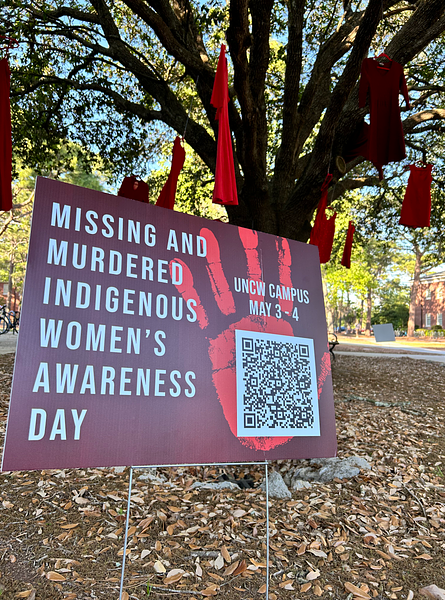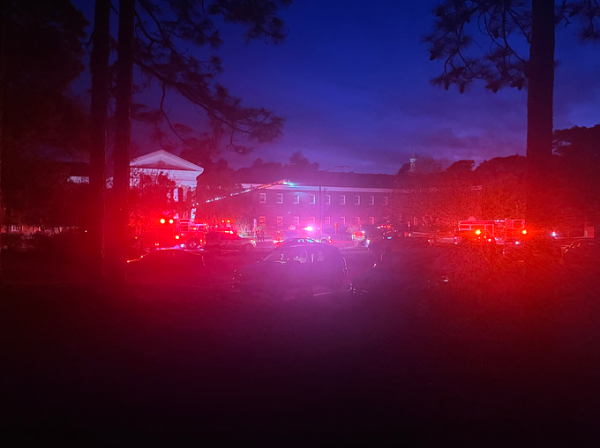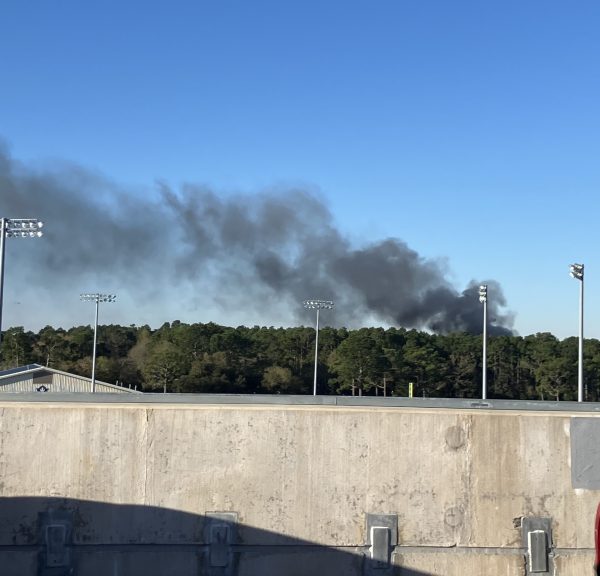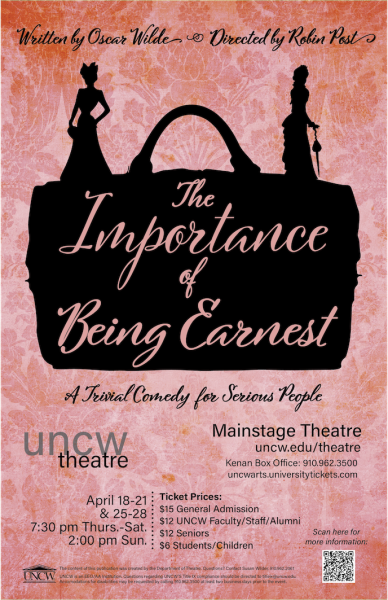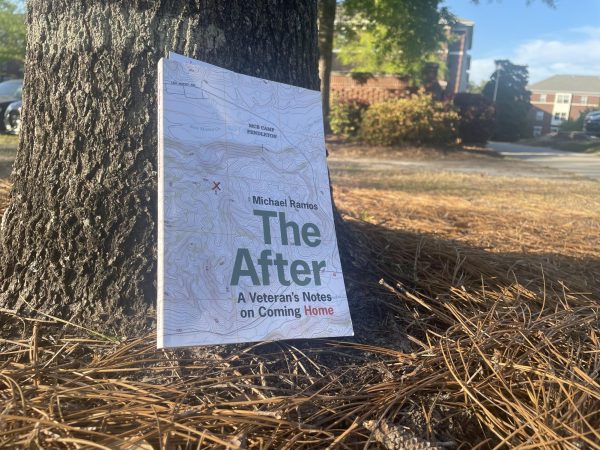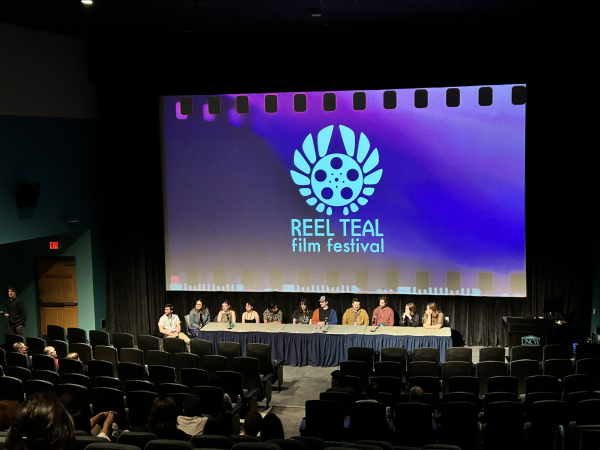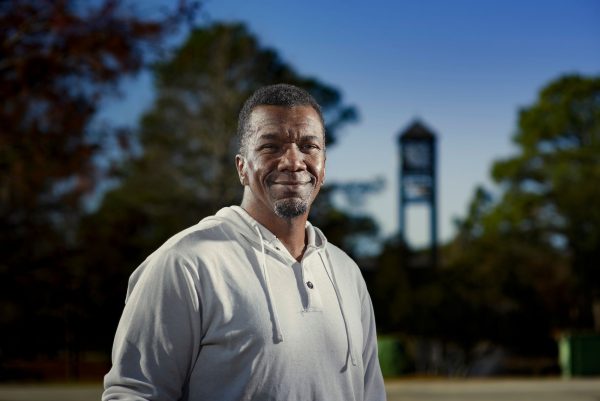Nine Inch Nails’ two new albums capture the ups and downs of 2020
Trent Reznor of Nine Inch Nails performs on Sunday, July 23, 2017 at FYF Fest in Exposition Park in Los Angeles, Calif. (Gary Coronado/Los Angeles Times/TNS)
April 7, 2020
We are living in weird times indeed. A global pandemic has put half of the countries in the world on lockdown, canceled almost all events and closed most schools. The star of “The Apprentice” is the president of the United States and he started 2020 by getting in a Twitter beef with Iran, putting both countries on edge. The large portion of Australia caught on fire, Kobe Bryant died in a plane crash and a biblical plague of locusts is eating East Africa. The most popular show on Netflix is about a tiger-owning, gun-toting, drug-abusing man known as Joe Exotic.
Weird times indeed. Lead singer Trent Reznor of Nine Inch Nails knows how weird times are, so when he dropped two brand new albums while most of the country was on lockdown, it only seemed fitting.
Nine Inch Nails has been around for over thirty years now, with countless amounts of sound experiments and singles. They are perhaps best known for two songs, “Closer” and “Hurt,” the latter of which was infamously covered by Johnny Cash. The group has sold over 20 million records, they have been nominated for 13 Grammy awards (two of which they have won), their song “34 Ghosts IV” was sampled in “Old Town Road” by Lil Nas X, and they are scheduled to be inducted into the Rock and Roll Hall of Fame in May of 2020.
It is easy to think of Nine Inch Nails as a “band,” but in truth, the group has consisted of one person at the center of the music, Trent Reznor. Reznor is notable for being the sole creative control in the studio with live performances consisting of a variety of backing musicians assembled by Reznor. Reznor was joined by Atticus Ross as an official member in 2016, after earning two Grammys with him for scores in “The Social Network” and “Gone Girl.”

Back in 2007, Nine Inch Nails released their sixth album, “Ghosts I-IV.” Until that point, the band was mostly a hard, industrial rock band. “Ghosts I-IV” was different because it was completely instrumental, had 36 songs on it without titles and was released under a Creative Commons License that allowed fans to use the music for any non-profit purpose. It was unheard of for a mainstream artist to do something so unique without any promotion whatsoever. In the same furtive manner, the group released a follow-up almost 13 years later in the midst of the COVID-19 pandemic with two albums, “Ghosts V: Together” and “Ghosts VI: Locusts,” or quite simply, “Ghosts V-VI.”
Much like the first series of “Ghosts,” both albums are completely instrumental and minimalistic, creating something that feels like a blank canvas for a world of imagery to build upon. Both albums are two sides to the same coin. They are night and day, yin and yang. The songs all have titles, a stark contrast to the first set of Ghosts, but their droning, long nature makes each song blend together.
Ghosts V: Together
“Letting Go While Holding On” opens the album with a droning sound that feels meditative and warm. Soft piano playing smoothly rides over the ambient chords. The gentle humming and droning make the listener feel lost in a world of sound, and by the end of the nearly 10-minute runtime, you are barely aware of the transition into the title track, “Together.” It is a score to the most relaxing movie that does not exist yet. The waves of sound gently crash against the shore. The relaxed piano playing is focused, almost distracting the listener from the growing hums in the background. “Together” is yet another ten-minute-long track. One word that could accurately describe “Ghosts V: Together” would be “flow.” Each song flows from movement to movement with seamless transitions. It is music to get lost in. Yet by the time “OUT IN THE OPEN” begins, the humming subtly shifts to become more anxious.
Beneath the serenity is something that appears more sinister. There is a rising tension that is lurking just out of reach foreshadowing things to come. “OUT IN THE OPEN” is only one of two songs that is less than seven minutes long on “Together.” The tracks are sprawling with unique beauty, only a growing sense of tension hides within the hums of each song. It is mostly an experiment that shows how a simple cord or note change can completely change the mood of a song. On songs like “Apart,” sounds gradually shift in and uproot the entire emotion of previously established sounds. The droning is still there, but then it turns to an industrial throbbing that feels anxious and tense. If there is a highlight to the first half of the two albums, then “Apart” is most certainly it. Everything that “Ghosts V: Together” does right makes an appearance.
The only escape from the seemingly endless drones comes in “Still Right Here,” which features a fast-paced and distorted industrial beat. Of the two releases, “Ghosts V: Together” feels more relaxed and brighter. It is a happier piece—perhaps an uneasy calm before the storm. The official Nine Inch Nails website says, “Ghosts V: Together is for when things seem like it might all be okay, and Ghosts VI: Locusts… well, you’ll figure it out.”
Ghosts VI: Locusts
If one could describe “Together” as “music to listen to while you let the sun softly warm your skin while a gentle breeze runs through your hair,” then “Locusts” is the sun getting blocked out by blackened rain clouds. If the first album is day, this album is the dead hours of night.
“The Cursed Clock” opens “Ghosts VI” with more piano, only this playing feels much more staccato and nervous. The humming has turned into a dissonant wailing and the notes are lower and more frantic. The song names are noticeably less abstract and much more horror-themed, compared to the tonally lighter earlier disk. Similarly, the track lengths feel shorter. Whereas on “Together,” five of the eight tracks are either close to 10 minutes long or even longer, the average song length on “Locusts” is around six minutes. Each track is punchier and anxious, yet still spare enough to build up one’s own imagery. “Around The Corner” keeps up the piano playing, only this time, a distant saxophone enters the mix. There is more variance in the sound that comes with the increased palate of noises. It feels much more mechanical and less free-flowing than its counterpoint. If “Together” is like taking a soft ride down a river, “Locusts” is a descent down the rapids. The movement can be felt, but it is hard not to feel scared of the destination.
“Run Like Hell” dilutes the mostly ambient music with more saxophone and a thunderous beat, “When It Happens (Don’t Mind Me)” is jarring and feels as though it was lifted directly from a horror movie soundtrack. The peaceful droning from “V” has morphed entirely into overwhelming anxiety. The album feels like taking a deep breath in, but a 50-pound weight on your chest is making it impossible to breathe out and you are stuck in a painful limbo. The turbulence lets up occasionally and becomes more uneasy than anxious, but starting with “Right Behind You,” the psychological weight of “Locusts” reaches its pinnacle.
“TURN THIS OFF PLEASE” is one of the most harrowing tracks ever released by the group. It is something of a climax to the album with the anxiety reaching an absolute maximum. It feels as though something is slowly chasing after you with each dissonant and broken note, to the point where it does not even sound quite like instruments are coming through the speakers. It feels as though the instruments are being jangled and scraped against each other. It is a nightmarish blend of sounds that somehow still resembles music.“So Tired” feels like the machinery is beginning to give way and lose steam as if the nightmare is almost over. When “Almost Dawn” hits, the song title immediately makes sense. If “Locusts” is a long night with no sleep, “Almost Dawn” is the sky turning grey just before the sun comes over the horizon. You are out of the woods now and you can finally sleep–it is a beautiful ending to a very bleak journey.
Overall, the two albums are perfect for isolation. “Ghosts V: Together” is the optimistic, bright and peaceful album, while “Ghosts VI: Locusts” is the negative, terrifying twin. They are a pair that complement each other very well while also suiting two very distinct and different moods. The length and repetition will prove as a hindrance to some listeners, but in many ways, the length makes it easier to get lost in. Art, particularly music, is the score for the film of life. No other set of albums could better represent the world in 2020 than “Ghosts V-VI.”
